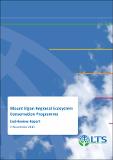| dc.description.abstract | The Mt Elgon Regional Ecosystem Conservation Programme (MERECP) is jointly funded by
the Governments of Norway and Sweden. MERECP is supporting a trans-boundary
ecosystem initiative under the auspices of the East African Community (EAC). MERECP
started in 2006 with a total funding of NOK 34.2 million (approximately USD 6 million) initially
for a period of 4 years and executed by the IUCN East Africa Regional Programme. The
project had a number of problems with regards to institutional arrangements, planning and
implementation. A Mid-Term Review, which took place in 2008, recommended a re-design of
MERECP. Since July 2009 the MERECP re-design phase is being executed by the Lake
Victoria Basin Commission (LVBC).
The main task of this End Review mission of MERECP was to measure outcome and
impact; efficiency and effectiveness of this re-design phase which has been operational for
more than 2 years. The End Review mission took place in the second half of September
2011 and reported back to a wrap-up meeting at the LVBC offices in Kisumu on the 3
October 2011.
The main problems identified by the Mid-Term Review included: (i) low ownership over the
project with national governments and the EAC; (ii) a high level of administrative costs and a
high percentage of project budget spent on coordination and meetings; (iii) a low percentage
of project funds (less than 20%) reaching the main beneficiaries (local communities); and (iv)
low level (50%) of work plan and budget execution.The re-design phase put the ownership squarely with EAC by housing MERECP with LVBC.
It also aimed at putting ownership with national governments and funds to protected area
management institutions (PAMI) and Districts now passed through Treasury and thereafter
disbursed and monitored by Focal Point Ministries. Also the re-design phase took an
approach of direct funding to community based organisations for the establishment of
Community Revolving Funds (CRFs) as well as directly involving them in natural resource
co-management forestry activities such as establishment of livelihood plantations and
enrichment planting. The PAMIs were put in the driving seat, managing MERECP work plans
and budgets.
The End Review Team’s (ERT) assessment concludes that the direct funding approach is
very promising and has created positive dynamics of collaboration and conflict resolution
between PAMIs and local communities. Local communities are experiencing the direct
impact on their livelihoods of the CRFs and tree planting activities. These activities are
instrumental in re-enforcing co-management models of the Mt Elgon Ecosystem. There
seems to be a good gender balance and representation in the programme delivery Both the LVBC and the PAMIs rightfully claim ownership over MERECP. MERECP has
inspired other such trans-boundary initiatives within the region such as Trans Boundary
Water for Biodiversity and Human Health in the Mara River Basin Project and the Lake
Chala-Jipe and Umba River ecosystems of Kenya and Tanzania. Also under the re-design
phase, despite less funds being channelled through Districts, the Districts on the Uganda
side are actively involved and supportive of MERECP in its direct support to local community
groups. However, work plan implementation and budget disbursement is still only 50% of
what was planned.
The ERT finds that funds passing through government Treasury of Uganda and Kenya
clearly pose a big challenge to effective project implementation. Also the Focal Point
Ministries are not the line ministries of the PAMIs and this does not favourably enhance
ownership and supervision in the right places. Communication lines for planning, funds
requests, disbursement and reporting are unnecessarily long and complicated under the
present institutional arrangement. The ERT concludes that the present institutional
arrangement is not effective and more direct funding lines should be established with the
otherwise semi-autonomous PAMIs. Also the ERT founds that under present arrangements auditing and of use of MERECP funds is difficult and insufficient. LVBC should establish
more effective financial monitoring systems.
The ERS clearly supports the general view of all project partners and stakeholders that there
should be a second phase of MERECP. Noting what has been achieved over the past 20
years in improving ecosystem health and co-management on Mt Elgon, the ERT takes a
long-term perspective and makes a number of concrete proposals for an exit of a project
mode of funding.
The ERT proposes that the CRF model developed by MERECP can form the basis for the
setting up of an Elgon Community Conservation Fund (ECCF). It is envisaged this fund will
provide annual direct funding to the Mt Elgon management institutions and local
communities to maintain collaborative management arrangements and for compensation of
avoiding deforestation and forest degradation.
Furthermore, MERECP should be a catalyst to ensure that the Mt Elgon Ecosystem is a
successful pilot able to demonstrate the delivery of sub-national reducing emissions from
deforestation and forest degradation (REDD+) strategies in Uganda and Kenya. It could be
also be pilot for testing monitoring, reporting and verification systems at the ecosystem level
as well as act as an institutional and financial mechanisms (such as the proposed ECCF) for
channelling carbon finance.Finally, the ERT begins to present the case for setting up of an investment fund for a largescale
land husbandry initiative in the Mt Elgon Ecosystem as a means to conserve and
protect this important water catchment and diverse agricultural landscape | en_US |

